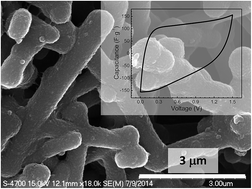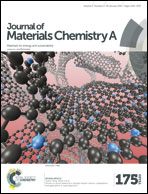Phosphorus-doped carbon–carbon nanotube hierarchical monoliths as true three-dimensional electrodes in supercapacitor cells†
Abstract
Eutectic mixtures of the monohydrated form of p-toluenesulfonic acid (pTsOH·H2O) and triethyl phosphate (TEP) in a 1 : 1 molar ratio were used as the medium to disperse previously functionalized multiwalled carbon nanotubes (MWCNTs), and to catalyse the polycondensation of furfuryl alcohol. Hierarchically structured P-doped carbon–CNT composites were obtained after carbonization. The high surface area, the phosphate functionalization, the hierarchical structure and the good electrical conductivity exhibited by these composites provided remarkable metrics when they were used as electrodes in a supercapacitor cell, with energy densities of around 22.6 W h kg−1 and power densities of up to 10 kW kg−1 for operational voltages of up to 1.5 V. This performance surpasses any performance previously reported for electrodes weighing (at least) 10 mg per cm2 of current collector and using an aqueous electrolyte. Actually, the supercapacitor cell built up with these electrodes provided enough neat energy to turn an IR LED of 30 mW on and emit light over a certain period.


 Please wait while we load your content...
Please wait while we load your content...